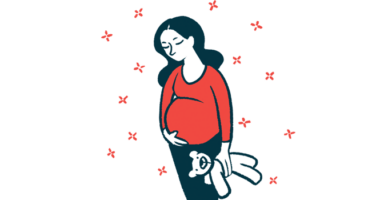Sharing special May birthdays with a new fellow columnist
A tale of a similar pregnancy sparks memories of my youngest son's birth

In May 1997, my husband, Randy, and I awaited the arrival of our third baby. The ultrasound indicated we were having a boy. We named him Jeffrey.
Years before, I’d taught at Brockman School, a self-contained setting for students with orthopedic and myriad other conditions considered severe and profound. In my first five years, my students primarily either ambulated independently or with walkers or crutches, or they wheeled themselves in power wheelchairs. Students in manual wheelchairs were pushed. In my sixth year, my students’ capabilities ranged from relatively independent to completely dependent.
Despite these conditions surrounding me, I had no qualms during my pregnancies with our first two children, Matthew and Katie. My pregnancy with Jeffrey, however, took a slight twist. During a routine exam, I asked my doctor if children who couldn’t move after birth had moved in utero. My doctor couldn’t answer. Why hadn’t I thought to ask that during my pregnancies while at Brockman?
I also started telling people expressing healthy-baby wishes that I wanted a happy baby. I’d wanted a healthy baby before. Why was “happy” my response now?
Something was up.
Jeffrey’s arrival
Because I was considered “mature” for a pregnancy, I underwent a series of nonstress tests during my final weeks. Jeffrey moved admirably in the first one but required prodding to move throughout the second one. During the lengthy wait for the third test, he wiggled constantly; once I was hooked up, we waited an hour for him to even squirm.
Jeffrey cooperated for the fourth test on May 13. The following day, Braxton Hicks (“practice”) contractions commenced. On May 15, my 43rd birthday, the nurse poked and prodded during the fifth test until she detected movement. Exciting changes observed in the subsequent exam suggested the wait was almost over. Sure enough, Jeffrey arrived on May 18. He was perfect!
Our third pregnancy had been a surprise to Randy and me. As the saying goes, though, we “ain’t seen nuthin’ yet.”
Happy baby, devastating diagnosis
Jeffrey adjusted with ease to the family’s bustling schedule. He only whimpered when he needed milk, a diaper change, or cuddling. Any of the three lulled him right to sleep. He barely moved, but I was enjoying his smiles too much to notice.
Jeffrey’s abdominal breathing lingered eight weeks after birth. Randy, concerned, asked my physician brother, Paul, to check him. Paul found a dull-sounding lung and no reflexes.
The following evening, a pediatric neurologist examined Jeffrey and revealed his findings. The preliminary diagnosis was SMA type 1, the deadliest form. Jeffrey would probably not live through preschool.
In shock, Randy and I rustled up determination to counter the despair and proceeded to battle SMA as best we could. As the insidious disease wreaked increasing devastation on Jeffrey, I realized I’d gotten my wish. We had one contented baby.
In spite of fervent prayers and relentless efforts to outwit SMA, Jeffrey snagged his wings on Nov. 4. He wasn’t even 6 months old.
Some familiar flashbacks
The blessings of our assignment included the opportunity to meet extraordinary fellow SMA families. As a Bionews columnist, I have colleagues who deal with various rare diseases. One fellow columnist, who at the time was living in North Carolina like us, shared a tragic connection to Hurricane Helene. I shared my late mother’s music with another columnist.
I discovered Paige Rivard through her column, “Finding Joy in the Journey.” Albeit for different reasons, Paige’s son — like Jeffrey — was a surprise. While I’d “randomly” asked the doctor about movement in utero, Paige asked questions in the third trimester because the movement waned.
In 2010, on May 17 — the day before Jeffrey’s birthday — Paige’s son was delivered by cesarean section. His crying resembled squeaking. His Apgar scores, indicating the baby’s health after birth, were normal, as were Jeffrey’s. But his breathing warranted a stay in the neonatal intensive care unit.
Paige writes, “He didn’t move, didn’t cry, and couldn’t feed or breathe on his own.” In a desperate quest for answers, her husband Googled the symptoms and landed on Prader-Willi syndrome. According to Paige, “Many of the characteristics listed were what our son was experiencing: low muscle tone (sometimes known as floppy baby syndrome), failure to thrive, sleeping almost 23 hours a day, etc.”
Boy, that sparks some memories.
Paige’s son was officially diagnosed with Prader-Willi syndrome. As Randy and I did during our SMA assignment, Paige and her husband have found blessings. They, too, strive to heighten awareness and raise funds. They’re elated about approval of the first drug to address the insatiable hunger in those with Prader-Willi — a perfect birthday gift for their son.

Left, a field of Texas bluebonnets, date unknown. Right, “blue bugles” this year in Jeffrey’s spot. Purchased years ago as ajuga, these surprising bluebonnet knockoffs of sorts have exploded in 2025. (Left, photo by Paul Derden; right, photo by Helen Baldwin)
As for Jeffrey’s 28th birthday gift? Hurricane Helene and a February ice storm left a crushing mess on our little mountaintop, the site of Jeffrey’s resting spot. I’ve worked diligently to clean it up.
Craving bluebonnets from my native Texas, I purchased a package of bluebonnet seeds last month to plant at Jeffrey’s site. The seeds flopped, but a flowering surprise awaited me on a recent cleanup day!
And I’m hoping I ain’t seen nuthin’ yet.
Note: SMA News Today is strictly a news and information website about the disease. It does not provide medical advice, diagnosis, or treatment. This content is not intended to be a substitute for professional medical advice, diagnosis, or treatment. Always seek the advice of your physician or other qualified health provider with any questions you may have regarding a medical condition. Never disregard professional medical advice or delay in seeking it because of something you have read on this website. The opinions expressed in this column are not those of SMA News Today or its parent company, Bionews, and are intended to spark discussion about issues pertaining to spinal muscular atrophy.









Leave a comment
Fill in the required fields to post. Your email address will not be published.